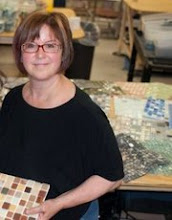certified glass mosaic tile, that we decided to post some of the FAQ'S on this topic. Please ask us your questions so we can get your answers posted for you.
Q: In describing recycled material content I hear the words pre and post consumer materials. What does Pre Consumer materials mean?
A: Pre-consumer materials are generated during the manufacturing process and may consist of scrap and trimmings that were never used in the consumer market.
Q: What does Post Consumer materials mean?
A: Post-Industrial Material is from manufacturing processes where virgin resources would otherwise go to waste. This material is collected and used in a product other than that for which it was originally used. Post-consumer material is an end product that has completed its life cycle as a consumer item and would otherwise have been disposed of as a solid waste. ORGANiKS 100% certified recycled glass tie is made completely from broken car windshields.
Q: We hear about LEED certification when it comes to green building. What does this mean?
A: LEED stands for Leadership in Energy and Environmental Design. It represents:
Regarding the ORGANiKS product, there were several questions as to the manufacturing process used in making this product. Here are a few we thought you might be interested in:
A:The water required to produce our glass mosaic is also minimum, around a 1%, and it evaporates during the manufacturing process.
A: The source of energy is electricity.
A: 100% of the glass that we use to produce our mosaics is recycled.
A: We use oxides.
A: We don't have residues because every defective product goes to the beginning of the production line and is recycled again.


3 comments:
I thought LEED included a requirement that products be made within 500 miles of their use. Isn't this tile made in Europe?
Q: How much energy is imbedded in the products you represent and what is the source of the energy?
A: The source of energy is electricity.
That isn't an answer.
To answer lucidglassworks comment, Susan needs to know the source of electricity used in her kilns. The majority of electricity in the US comes from fossil fuel fired generators. There is a significant carbon footprint associated with using that electrical power. So you need to verify that your source of electricity generates little or no carbon emissions. Then we can move on to other environmental impacts.
Unless you have a truly "green" source of electricity, natural gas fired kilns can offer a substantial reduction in carbon emissions due to increased firing efficiencies. This principal applies no matter where the tiles are fused, in the US or, as the first commenter notes, in Europe.
Post a Comment